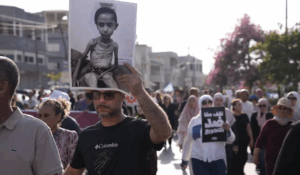This protest won’t end the hunger in Gaza but for Israeli Arabs it tore through a wall of fear

Protest in Sakhnin on 25 July 2025
Jack Khoury writes in Haaretz on 26 July 2025:
A protest march and rally held Friday in the northern Israeli town of Sakhnin under the banner “No to Starvation in Gaza” and calling for an end to the war served as a powerful reminder of the delicate position many Arab citizens of Israel find themselves in: deeply tied to their Israeli citizenship, yet unwilling to stay silent in the face of what they see as a humanitarian catastrophe befalling their people in Gaza.
More than 10,000 people took part in the march, which set out from Al-Shuhada Street in central Sakhnin – a street that has become the symbolic starting point of nearly every major demonstration in the city over the past two decades. Among the participants were Arab and Jewish citizens, including families with young children. While the crowd was smaller than in some past national rallies, the turnout was nonetheless significant. It came despite intense summer heat and an increasingly hostile climate toward Arab citizens since Hamas’ October 7 attack.
Many protesters saw their participation as an act of courage, breaking through what they described as a wall of fear that has gripped Arab citizens of Israel, who make up roughly 20 percent of the country’s population, since the war began.
Participants called attention to the ongoing destruction in Gaza, where nearly 60,000 people have been killed and tens of thousands more wounded since the start of the war. A large proportion of the casualties are women and children.
For months, most of Israel’s Arab citizens bit their tongues and stayed silent. But in recent weeks, the sense of quiet despair has given way to something closer to moral outrage. Gruesome images, survivor testimonies, and near-daily reports from Arabic-language and international media about the scale of destruction and starvation in Gaza have overwhelmed many. For those still guided by conscience, one speaker said, the mood is not just sorrow – it’s a heavy, paralyzing grief.
“This is no longer about defeating Hamas or freeing the hostages,” one organizer explained. “This is punishment. Vengeance. A cruelty approaching annihilation.”
That was the message demonstrators in Sakhnin hoped to send, as thousands sought – at last – to break free from the helplessness and silence that had weighed on them since the war began.
A year ago, there was a brief surge of grassroots activism in Arab communities, as civil society groups and political parties launched a spontaneous humanitarian aid campaign for Gaza. Thousands of tons of food and water were donated by the public. But much of it spoiled in storage, never reaching its destination. Only a small fraction made it into the Strip through international organizations. That failure deepened the frustration and anger among Arab citizens – though most still hesitated to protest publicly.
Their caution is not without reason. The memory of 13 Arab citizens killed by police in October 2000 during mass protests, and the violent clashes that erupted during the May 2021 Gaza war, still loom large. In the current political climate, some fear that the risks could be even greater.
The hostile rhetoric against Arab citizens and their elected representatives in Israel – amplified by what critics describe as the government’s increasingly racist policies – has seeped into nearly every level of society, down to the rank-and-file of law enforcement.
That was plainly visible in Sakhnin on Friday, where Israel’s special police units, including Border Police and riot control forces, were deployed inside the city and along the march route – a scene that has not been witnessed in Arab towns in years.
For two decades, Israeli police largely refrained from entering the heart of demonstrations in Arab communities, especially when the protests had a national or Palestinian character. Instead, they monitored such events from a distance, set up checkpoints outside town entrances, and maintained a relatively low profile. When officers were present on site, they typically came without heavy reinforcements from paramilitary units.
This time, the atmosphere was markedly different. Police arrived prepared for confrontation, with visible forces and crowd-control vehicles, including a water cannon stationed near the municipal square. Though officials often justify such deployments by citing fears of incitement or “support for terrorism” – such as chants or Palestinian flags – witnesses described the protest as peaceful and restrained.
No Palestinian flags were waved, save for a symbolic gesture in which a single flag was tied to balloons and released into the sky. Demonstrators also avoided past slogans like “Gaza will not surrender to tanks and cannons,” opting instead for calls to end the war and stop the hunger, while holding up images of starving children. The loudest sounds came not from chants, but from the rhythmic banging of pots and pans.
And so, the dozens of police officers deployed in Sakhnin found themselves with little to do on a quiet Friday afternoon. “We won’t play into their hands,” said a young man wearing a red keffiyeh, standing beside Jewish Israeli demonstrators – whose presence was especially noticeable at this protest.
Amidst the fear, tension, and political turmoil gripping the country, the march in Sakhnin offered a rare moment of calm, dignity, and moral clarity. It won’t change government policy, protesters acknowledged. It won’t sway Israel’s hardline leadership, nor will it reach the halls of the White House.
But it did something else: it pierced the wall of fear that has kept many silent, giving thousands of Arab citizens – and their Jewish allies– a chance to take a stand on basic human grounds. Their message was clear: End the war. Stop the starvation in Gaza.
This article is reproduced in its entirety
